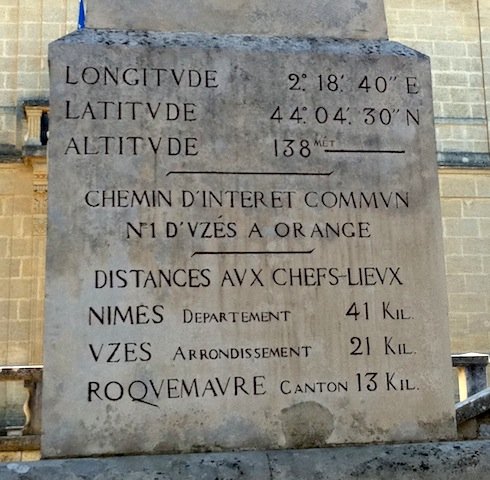I know I’ve been back for a while now, but there was one thing I’ve been meaning to blog about. The place we were staying was only a village, really, but in the best French manner it had a town square with a handsome town hall, in front of which was an obelisk-shaped monument that looked like it might be a memorial to the dead of the Great War, or just an ornamental drinking fountain.
But when I wandered over to look at a face carved into the top of the obelisk, it turned out to be Galileo. Which seemed a bit odd. Surely the great man had no connection to this little village in Languedoc? And on the other side was a portrait of Isaac Newton. But it gets better:

Yup, as a nearby sign explained, this is a monument in honour of the metric system, erected by the mayor of St-Victor La-Coste in 1888 for the centenary of the French Revolution.
Admittedly, given that the French revolution was, among other things, a brutal, blood-drenched clash of social classes competing for the chance to wield power, it might be seen as whitewashing to memorialise it as a rationalist Enlightenment project typified by a sensible reform of the system of measurements. But the French are hardly alone in being selective about the bits of their history they choose to celebrate.
And you know what, the metric system is a pretty great idea. Hurrah for the C19th French provincial bourgeoisie and their civic pride in the ideals of the Enlightenment.
On the other three sides of the obelisk, there are a list of the mayor and local council members who erected it, and some further details about the town. But my favourite bit is this:

I love that boast: ‘The metre adopted in France in 1795; the rest of Europe in 1872’. I’m just surprised they resisted the temptation to add a line saying ‘England: still in the dark ages’.
Originally there were also a thermometer and a barometer attached to the monument, but they have sadly gone.
Incidentally, I just love the typography.

The numerals and the Q are particularly pleasing, but the whole effect is very good; it’s a pretty standard Roman-style inscription but it has a bit of character. Perhaps it’s just the extra personality that comes with being hand carved by a real craftsman; we are surrounded by too much bland computer-generated signage these days. I miss hand-painted shop signs.
5 replies on “Belated France follow-up, French civic geekery edition”
That is perhaps my new favorite piece of public art anywhere. The idea of a monument to a pleasingly efficient system that is usable by science? It’s a tiny miracle. I think the E has a nice bit of style, too, although not as personalized as the Q.
Pleasing, isn’t it.
Really though, that was quite a long time then – 45 years – before they could say the old measures were abolished, and even now, or certainly a few years ago, you could ask for ‘une livre d’abricots’ (for example) on a market.
Have you read Graham Robb’s ‘The Discovery of France’? I imagine you’d enjoy it.
The ‘Q’ looks particularly funny with the Vs for U’s, doesn’t it? I suppose it was pretty much unknown in Roman lettering.
But it really is a very pleasing thing!
45 years does sound like quite a long time, but they did have a few distractions to deal with, like the Napoleonic Wars. There’s no such excuse for the UK: we committed to metrication in 1965 [a mere 275 years after the French did] and 45 years on we still haven’t completely abolished the old measures, since we have miles on road signs and sell beer in pints.
I haven’t read the Graham Robb, I’ll look out for it. It sounds like it covers similar ground to a superb book by Eugen Weber called Peasants into Frenchmen which I would thoroughly recommend. That’s where I learned the old saying: ‘Pigs and moneylenders; you never now how much they’re worth until they’re dead’.
I just glanced in the Weber to see what it had to say about metrication, and apparently despite the law of 1840, there were places where the old units were used almost exclusively right to the end of the C19th. Which raises a possibility I hadn’t considered: perhaps the mayor of St Victor La Coste wasn’t celebrating the metric system at all; perhaps instead he was advertising it, trying to educate the locals and persuade them to finally adopt the new units.
It’ll be interesting to see how long the old units linger in the UK. I imagine that for commercial purposes we should switch over fairly quickly, because the government has enough bureaucratic power to make businesses switch, and consumers have no choice but to adapt. But for things where the law has less purchase, like giving people’s height in feet and inches and weight in stone, I daresay they could linger indefinitely.
And if the sentimental exception for beer is ever removed, I’m quite sure we’ll just call a 500ml glass a pint, and a 250ml glass a half.